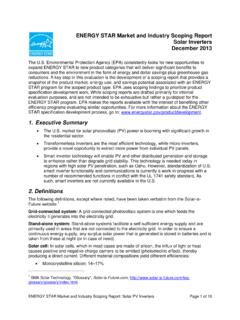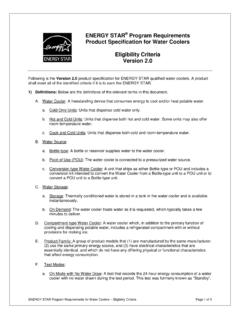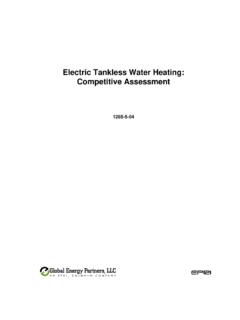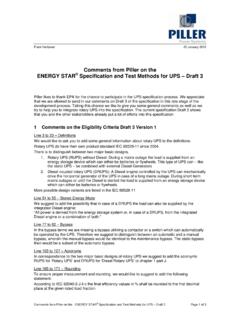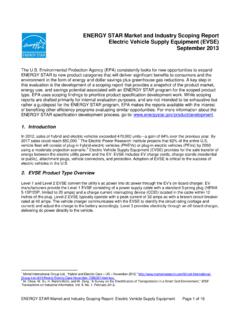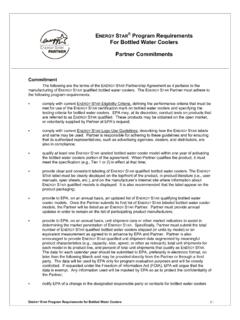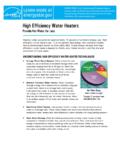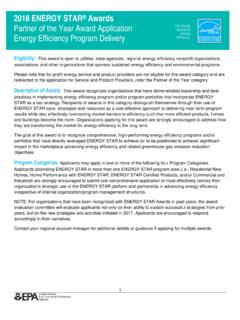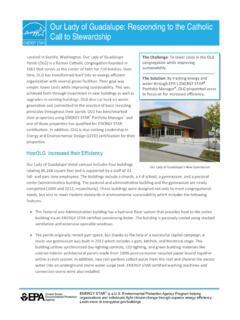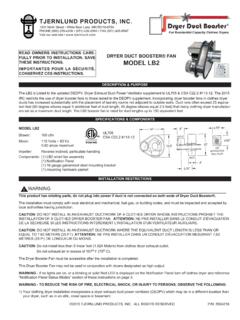Transcription of 8. Air Distribution Systems - Energy Star
1 Energy star Building Manual18. Air Distribution SystemsRevised April 2008 Overview 2 Air-Handling system Types 3 Constant-Volume Systems 3 Variable Air Volume Systems 5 Air-Handling Components 6 Fans 7 Filters 7 Ducts 9 Dampers 10 Best Opportunities 10 Optimize Zone-Level Performance 10 Convert CV Systems to VAV 12 Rightsize Fans 14 Install Variable-Speed Drives 16 Modify Controls 17 Pick Premium-Efficiency Motors 23 Use Energy -Efficient Belt Drives 25 Consider a Testing, Adjusting, and Balancing Contractor 26 Summary 26 Bibliography 26 Glossary G-1 Energy star Building Manual28. Air Distribution OverviewAir Distribution Systems bring conditioned (heated and cooled) air to people occupying a building, and therefore directly affect occupant comfort.
2 Over the last several decades, signifi-cant improvements have been made to the design of air Distribution Systems as well as to the way in which these Systems are controlled. These improved designs and controls can result in dramatic Energy savings, yet many buildings continue to rely on obsolete, inefficient Systems for this critical function. The Energy savings achieved in the Retrocommissioning, Lighting, and Supplemental Load Reductions stages (Figure ) are likely to have reduced the load on the building s HVAC system , sometimes considerably. But before evaluating the potential to replace the existing heating and/or cooling equipment with smaller and more-efficient equipment, optimize the efficiency of the air Distribution system itself.
3 Doing so may well enable even greater savings and a reduction in required heating and cooling equipment average, the fans that move conditioned air through commercial office buildings account for about 7 percent of the total Energy consumed by these buildings (Figure ), so reductions in fan consumption can result in significant Energy savings. A Environmental Protection Agency (EPA) study found that almost 60 percent of building fan Systems were oversized by at least 10 percent, with an average oversizing of 60 percent. Rightsizing a fan system , or better matching fan capacity to the requirements of the load, is an excellent way to save Energy in air Distribution sys-tems.
4 There are also opportunities for Energy -saving improvements to the air Distribution system in four other categories: adjusting ventilation to conform with code requirements or occupant needs, implementing Energy -saving controls, taking advantage of free cooling where possible, and optimiz-ing the efficiency of Distribution system components. This chapter will describe the opportunities in each of these areas, but first, it is important to gain an understanding of the types of Systems that are commonly encountered and the various components of air Distribution The staged approach to building upgradesThe staged approach to building upgrades accounts for the interactions among all the Energy flows in a building.
5 Each stage includes changes that will affect the upgrades performed in subsequent stages, thus setting the overall process up for the greatest Energy and cost savings possible. The air Distribution Systems stage takes advantage of the load reductions achieved in earlier Distribution Systems upgradeLightingupgradeHVAC upgradeSupplementalload reductionsStages of an integrated upgrade approachBase loadRetrocommissioningNew base loadCourtesy: E SOURCEENERGY star Building Manual38. Air Distribution Air-Handling system TypesThere are two types of air-handling Systems : constant volume (CV) and variable air volume (VAV).
6 In a CV system , a constant amount of air flows through the system whenever it is on. A VAV system changes the amount of airflow in response to changes in the heating and cooling load. VAV Systems offer substantial Energy savings and are becoming more widespread. Constant-Volume SystemsConstant-volume Systems are the simplest type of air Distribution system and are installed in a large percentage of existing commercial buildings. In a CV system , when the supply fan is on, a constant amount of air flows through; there is no modulation of the fan power, no discharge dampering at the fan, and no dampering at the terminal ends of the duct runs.
7 In its simplest configuration, a CV system serves a single space (also called a zone). A thermostat is located in the zone that senses space temperature and sends signals to the air-handling unit to provide heating or cooling based on the thermostat Systems . In larger buildings, CV Systems serve multiple zones with varying heating or cooling requirements. For example, a perimeter office with a vast expanse of south-facing glass may require cooling in the middle of December when the rest of the building requires heating. Constant-volume Systems that serve multiple zones are typically designed with some way to vary the temperature of air delivered to each zone.
8 To meet differing cooling loads with a CV system , terminal reheat or zone reheat is frequently added: an electric resistance element, hot water coil, or other heat source that reheats the cooled air just before it enters the room. The system is sized to provide cooling to the zone with the peak load, and all zones with less cooling load have their air reheated as it enters the zone. In humid climates, reheat Systems not only provide terminal control but also strip moisture out of the supply airstream by allowing deep cooling of the primary air. Figure : Typical electricity consumption in commercial office buildingsThe power used to circulate conditioned air accounts for approximately 7 percent of commercial office building electricity 29%Office equipment 26%Lighting 22%Other 7%Ventilation 7%Space heating 6%Water heating 1%Refrigeration 1%Cooking1%Source: Department of Energy Energy star Building Manual48.
9 Air Distribution SystemsReheat Systems are as inefficient as they sound: Energy is used first to cool and then to reheat the air. The thermostat in a CV-supplied zone only controls the amount of reheat applied to that zone s air. If reheat is not applied, zones will be overcooled, possibly to uncomfortable lev-els. CV Systems without temperature reset (thermostatic control of the supply-air temperature) are now prohibited by many Energy , variable-temperature (CVVT) Systems . A CV system that adjusts or resets the temperature of the supply air is a CVVT system . As cooling loads decrease, chilled water flow is reduced (or reset in control system parlance) to create warmer supply air.
10 This reset can be controlled by monitoring either the outside air temperature (outside-air reset) or the cooling needs of the warmest zone (warmest-zone reset). Although outside-air reset has simpler controls and thus may be more reliable, it bases its strategy on the frequently incorrect assumption that cooling load varies linearly with the temperature of the outside air. Solar gain through the windows and internal heat gain from people, lights, and equipment all impact the cooling load independently of the outside temperature. Warmest-zone reset, which directly monitors the indoor air temperature of interest, is more accurate: the supply-air temperature is set just low enough to cool the zone with the highest cooling load.
